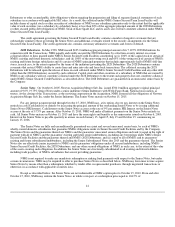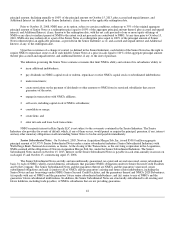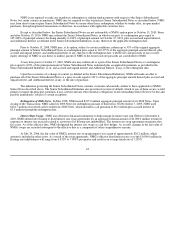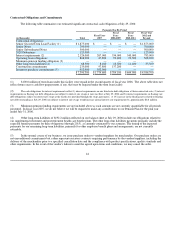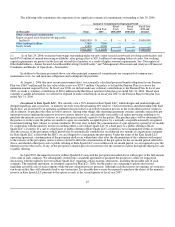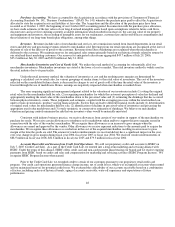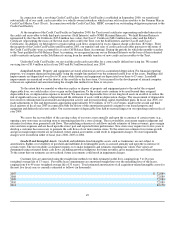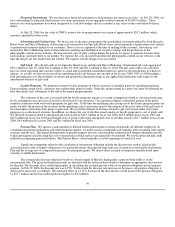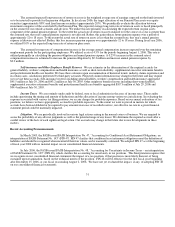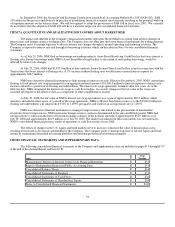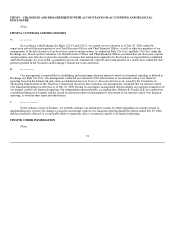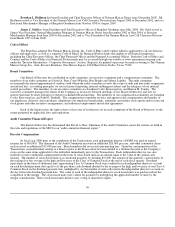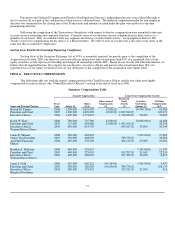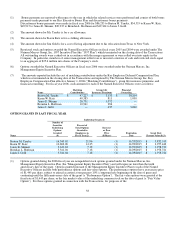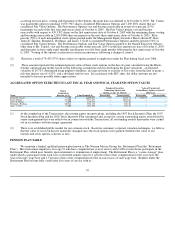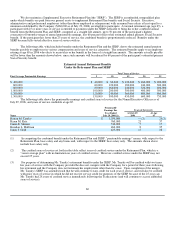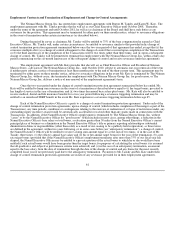Neiman Marcus 2005 Annual Report Download - page 55
Download and view the complete annual report
Please find page 55 of the 2005 Neiman Marcus annual report below. You can navigate through the pages in the report by either clicking on the pages listed below, or by using the keyword search tool below to find specific information within the annual report.
The assumed expected long-term rate of return on assets is the weighted average rate of earnings expected on the funds invested
or to be invested to provide for the pension obligation. In fiscal year 2006, the target allocation of our Pension Plan assets was equity
securities (approximately 80%) and fixed income securities (approximately 20%). We periodically evaluate the allocation between
investment categories of the assets held by the Pension Plan. The expected average long-term rate of return on assets is based principally
on the counsel of our outside actuaries and advisors. We utilize this rate primarily in calculating the expected return on plan assets
component of the annual pension expense. To the extent the actual rate of return on assets realized over the course of a year is greater than
the assumed rate, that year's annual pension expense is not affected. Rather, this gain reduces future pension expense over a period of
approximately 12 to 18 years. To the extent the actual rate of return on assets is less than the assumed rate, that year's annual pension
expense is likewise not affected. Rather, this loss increases pension expense over approximately 12 to 18 years. During fiscal year 2006,
we utilized 8.0% as the expected long-term rate of return on plan assets.
The assumed average rate of compensation increase is the average annual compensation increase expected over the remaining
employment periods for the participating employees. We utilized a rate of 4.5% for the periods beginning August 1, 2006. This rate is
utilized principally in calculating the pension obligation and annual pension expense. A 0.25% increase in the assumed rate of
compensation increase is estimated to increase the pension obligation by $2.3 million and increase annual pension expense by
$0.3 million.
Self-insurance and Other Employee Benefit Reserves. We use estimates in the determination of the required accruals for
general liability, workers' compensation and health insurance as well as short-term disability, supplemental executive retirement benefits
and postretirement health care benefits. We base these estimates upon an examination of historical trends, industry claims experience and,
in certain cases, calculations performed by third-party actuaries. Projected claims information may change in the future and may require
us to revise these accruals. Self-insurance reserves including general liability, workers' compensation and health insurance aggregated
$45.5 million at July 29, 2006 and $43.2 million at July 30, 2005. Other employee benefit reserves including short-term disability,
supplemental executive retirement benefits and postretirement health care benefits aggregated $107.6 million at July 29, 2006 and
$94.4 million at July 30, 2005.
Income Taxes. We are routinely under audit by federal, state or local authorities in the areas of income taxes. These audits
include questioning the timing and amount of deductions and the allocation of income among various tax jurisdictions. In evaluating the
exposure associated with various tax filing positions, we accrue charges for probable exposures. Based on our annual evaluations of tax
positions, we believe we have appropriately accrued for probable exposures. To the extent we were to prevail in matters for which
accruals have been established or be required to pay amounts in excess of recorded reserves, our effective tax rate in a given financial
statement period could be materially impacted.
Litigation. We are periodically involved in various legal actions arising in the normal course of business. We are required to
assess the probability of any adverse judgments as well as the potential range of any losses. We determine the required accruals after a
careful review of the facts of each significant legal action. Our accruals may change in the future due to new developments in these
matters.
Recent Accounting Pronouncements
In March 2005, the FASB issued FASB Interpretation No. 47, "Accounting for Conditional Asset Retirement Obligations, an
interpretation of FASB Statement No. 143" (FIN 47). FIN 47 clarifies that conditional asset retirement obligations meet the definition of
liabilities and should be recognized when incurred if their fair values can be reasonably estimated. We adopted FIN 47 as of the beginning
of fiscal year 2006 with no material impact on our consolidated financial statements.
In July 2006, the FASB issued FASB Interpretation No. 48, "Accounting for Uncertainty in Income Taxes – an interpretation
of FASB Statement No. 109" (FIN 48), which clarifies the accounting for uncertainty in tax positions. This Interpretation requires that
we recognize in our consolidated financial statements the impact of a tax position, if that position is more likely than not of being
sustained upon examination, based on the technical merits of the position. FIN 48 will be effective for the first fiscal year beginning
after December 15, 2006, or our fiscal year ending August 2, 2008. We have not yet evaluated the impact, if any, of adopting FIN 48
on our consolidated financial statements.
51


